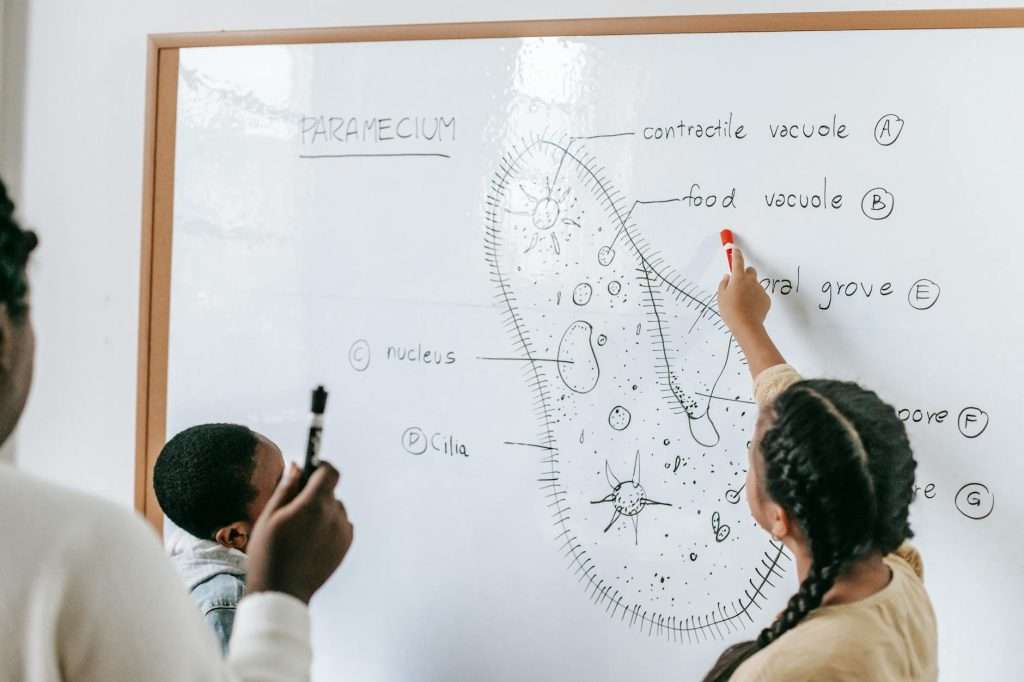Have you ever felt overwhelmed when trying to master a new subject? 🤯 You’re not alone. Many learners struggle to find an effective approach to tackle complex topics. But what if there was a proven framework to help you learn faster and more efficiently?
Enter Bloom’s Taxonomy – your secret weapon for conquering any subject. This powerful learning tool breaks down the cognitive process into six levels, allowing you to systematically climb the learning ladder. By understanding and applying these levels, you’ll transform from a passive learner into an active knowledge creator. 🚀
In this blog post, we’ll guide you through each level of Bloom’s Taxonomy, from building your knowledge foundation to synthesizing information for innovation. You’ll discover practical strategies to accelerate your learning journey and master any subject with confidence. Ready to revolutionize your learning approach? Let’s dive in and explore how Bloom’s Taxonomy can help you reach new heights in your educational pursuits!
Understanding Bloom’s Taxonomy
The six levels of cognitive learning
Bloom’s Taxonomy consists of six hierarchical levels of cognitive learning, each building upon the previous one. These levels are:
- Remember
- Understand
- Apply
- Analyze
- Evaluate
- Create
Here’s a breakdown of each level and its associated cognitive skills:
| Level | Cognitive Skills |
|---|---|
| Remember | Recall, recognize, list, identify |
| Understand | Explain, summarize, interpret, classify |
| Apply | Use, implement, solve, demonstrate |
| Analyze | Compare, organize, deconstruct, attribute |
| Evaluate | Judge, critique, justify, assess |
| Create | Design, construct, plan, produce |
How it applies to mastering any subject
You can use Bloom’s Taxonomy as a roadmap for mastering any subject. By progressing through each level, you’ll deepen your understanding and develop more advanced cognitive skills. For example, when learning a new language:
- Remember vocabulary and basic grammar rules
- Understand sentence structures and context
- Apply your knowledge in simple conversations
- Analyze native speakers’ speech patterns
- Evaluate your own language proficiency
- Create original content in the new language
Benefits of using this framework
Adopting Bloom’s Taxonomy in your learning process offers several advantages:
- Structured approach: Provides a clear path for progression
- Comprehensive learning: Ensures you cover all aspects of a subject
- Deeper understanding: Encourages critical thinking and analysis
- Self-assessment: Helps you identify areas for improvement
- Versatility: Applicable to any subject or skill you want to master
By consciously moving through these cognitive levels, you’ll accelerate your learning process and achieve a more thorough mastery of your chosen subject. Now that you understand the framework, let’s explore each level in detail, starting with the foundation: Remember.
Level 1: Remember – Building Your Knowledge Foundation

Techniques for effective memorization
When it comes to building your knowledge foundation, effective memorization techniques are crucial. Here are some proven methods to help you remember information more efficiently:
- Chunking: Break large pieces of information into smaller, manageable chunks.
- Visualization: Create mental images to associate with facts or concepts.
- Mind mapping: Organize information visually to see connections between ideas.
- The method of loci: Associate information with specific locations in a familiar space.
| Technique | Description | Best for |
|---|---|---|
| Chunking | Group related items | Lists, numbers |
| Visualization | Create mental images | Abstract concepts |
| Mind mapping | Connect ideas visually | Complex topics |
| Method of loci | Use spatial memory | Sequences, processes |
Creating flashcards and mnemonic devices
Flashcards and mnemonic devices are powerful tools for reinforcing your memory. To create effective flashcards:
- Keep information concise
- Use both text and images
- Review regularly
- Shuffle your deck to avoid order memorization
Mnemonic devices can take various forms:
- Acronyms (e.g., ROY G. BIV for colors of the rainbow)
- Acrostics (e.g., “Every Good Boy Does Fine” for musical notes)
- Rhymes or songs
- Word associations
Spaced repetition for long-term retention
Spaced repetition is a scientifically-proven technique to enhance long-term memory retention. Here’s how you can implement it:
- Review new information within 24 hours of learning it
- Gradually increase the intervals between reviews
- Focus more on difficult items and less on easily remembered ones
- Use apps like Anki or Quizlet that incorporate spaced repetition algorithms
By combining these techniques, you’ll build a solid foundation of knowledge that will serve you well as you progress through the higher levels of Bloom’s Taxonomy. Next, we’ll explore how to move beyond mere memorization to truly understanding core concepts.
Level 2: Understand – Grasping Core Concepts

A. Summarizing key ideas in your own words
Now that you’ve built a solid foundation of knowledge, it’s time to deepen your understanding. Summarizing key ideas in your own words is a powerful technique to grasp core concepts. When you rephrase information, you’re not just regurgitating facts; you’re actively processing and internalizing the material.
Try these strategies to improve your summarization skills:
- Identify main points
- Eliminate unnecessary details
- Use your own vocabulary
- Create concise explanations
| Original Text | Your Summary |
|---|---|
| Complex jargon | Simple language |
| Lengthy explanations | Concise statements |
| Multiple examples | One clear example |
B. Connecting new information to existing knowledge
To truly understand a subject, you need to integrate new information with what you already know. This process, known as elaboration, helps you create meaningful connections and enhances your overall comprehension.
Here are some ways to connect new and existing knowledge:
- Draw mind maps
- Create analogies
- Relate concepts to personal experiences
- Identify similarities and differences with familiar topics
C. Using analogies and examples to reinforce understanding
Analogies and examples are powerful tools for reinforcing your understanding of complex concepts. They bridge the gap between abstract ideas and concrete experiences, making it easier for you to grasp and remember new information.
Consider these techniques:
- Create visual analogies
- Use real-world examples
- Develop storytelling analogies
- Apply concepts to different contexts
Remember, the key to mastering this level of Bloom’s Taxonomy is active engagement with the material. By summarizing, connecting, and illustrating concepts, you’re not just memorizing information – you’re developing a deep, flexible understanding that will serve as a foundation for higher-level thinking skills.
Level 3: Apply – Putting Knowledge into Practice

A. Solving problems using learned concepts
Now that you’ve grasped the core concepts, it’s time to put your knowledge to work. Solving problems is where the rubber meets the road in your learning journey. By tackling real-world issues, you’ll cement your understanding and develop practical skills.
Here’s a quick guide to effective problem-solving using Bloom’s Taxonomy:
- Identify the problem
- Recall relevant concepts
- Apply appropriate methods
- Evaluate your solution
Try this approach with various subjects to enhance your learning:
| Subject | Problem-Solving Example |
|---|---|
| Math | Solve word problems |
| History | Analyze historical events |
| Science | Design experiments |
| Language | Translate texts |
B. Hands-on exercises and simulations
Nothing beats hands-on experience when it comes to learning. Engage in practical exercises and simulations to reinforce your knowledge. These activities provide a safe environment to experiment and learn from mistakes.
Consider these hands-on learning methods:
- Role-playing scenarios
- Virtual labs and simulations
- DIY projects related to your subject
- Interactive online courses
C. Real-world applications of theoretical knowledge
Bridging the gap between theory and practice is crucial for mastering any subject. Look for opportunities to apply your knowledge in real-life situations. This approach not only solidifies your understanding but also demonstrates the relevance of what you’re learning.
To apply your knowledge effectively:
- Identify relevant situations in your daily life
- Volunteer for projects that utilize your skills
- Participate in internships or apprenticeships
- Teach others what you’ve learned
By actively applying your knowledge, you’ll move beyond mere understanding and develop a deeper, more practical mastery of your chosen subject.
Level 4: Analyze – Breaking Down Complex Ideas

Identifying patterns and relationships
As you progress through Bloom’s Taxonomy, you’ll find that analyzing complex ideas becomes a crucial skill. Start by looking for patterns and relationships within the subject matter. This process helps you understand the underlying structure and connections between different concepts.
To enhance your analytical skills, try these techniques:
- Mind mapping
- Concept clustering
- Cause-and-effect diagrams
- Venn diagrams
These visual tools can help you identify patterns and relationships more effectively. For example, create a mind map of the main topics in your subject and draw connections between related ideas.
Comparing and contrasting different concepts
One of the most powerful analytical tools is the ability to compare and contrast different concepts. This skill allows you to:
- Identify similarities and differences
- Understand nuances between related ideas
- Recognize unique characteristics of each concept
Use this table to organize your comparisons:
| Concept A | Similarities | Concept B |
|---|---|---|
| Unique features of A | Shared traits | Unique features of B |
| … | … | … |
Critical thinking exercises to enhance analytical skills
To sharpen your analytical abilities, engage in critical thinking exercises regularly. These activities will help you break down complex ideas and examine them from multiple angles:
- Ask “why” five times to dig deeper into a concept
- Analyze arguments by identifying premises and conclusions
- Evaluate sources of information for credibility and bias
- Practice solving open-ended problems with multiple solutions
Remember, developing strong analytical skills takes time and practice. By consistently applying these techniques, you’ll become more adept at breaking down complex ideas and understanding their underlying structures.
Level 5: Evaluate – Developing Critical Judgment

A. Assessing the validity of arguments and theories
As you climb higher on Bloom’s Taxonomy, you’ll find yourself at the “Evaluate” level, where critical judgment becomes crucial. Here, you’ll learn to assess the validity of arguments and theories, a skill that’s invaluable in any field.
To effectively evaluate arguments and theories, consider the following criteria:
- Evidence: Is there sufficient and reliable evidence to support the claim?
- Logic: Does the argument follow a coherent and rational structure?
- Bias: Are there any potential biases influencing the theory or argument?
- Alternatives: Have other explanations been considered and ruled out?
Use this table to help you systematically evaluate arguments:
| Criterion | Questions to Ask | Example |
|---|---|---|
| Evidence | Is it empirical? Peer-reviewed? | Research studies, expert opinions |
| Logic | Are there fallacies? Is it consistent? | Cause-effect relationships |
| Bias | Who benefits? What’s the source? | Funding sources, personal stakes |
| Alternatives | What other explanations exist? | Competing theories, null hypothesis |
B. Critiquing methods and approaches
Now that you can assess arguments, it’s time to critique the methods and approaches used in your field of study. This involves:
- Identifying the methodology used
- Analyzing its strengths and weaknesses
- Comparing it to alternative methods
- Considering its applicability to different contexts
By mastering this skill, you’ll be able to discern which approaches are most effective for solving problems or advancing knowledge in your area of interest.
C. Forming well-reasoned opinions on complex topics
The ultimate goal of the “Evaluate” level is to form your own well-reasoned opinions on complex topics. This requires synthesizing all the skills you’ve developed so far:
- Gathering relevant information
- Understanding multiple perspectives
- Applying critical thinking
- Analyzing interconnected factors
- Evaluating evidence and arguments
Remember, forming opinions isn’t about being right or wrong, but about developing a nuanced understanding of complex issues. As you practice these skills, you’ll find yourself becoming a more discerning learner and thinker, ready to tackle the highest level of Bloom’s Taxonomy: Create.
Level 6: Create – Synthesizing Knowledge for Innovation

Generating new ideas and hypotheses
Now that you’ve mastered the lower levels of Bloom’s Taxonomy, it’s time to unleash your creativity and innovation. At this pinnacle of learning, you’ll synthesize your knowledge to generate groundbreaking ideas and formulate novel hypotheses. This process involves combining concepts from various sources, identifying patterns, and making unique connections.
To excel at this level:
- Practice brainstorming techniques
- Explore unconventional perspectives
- Combine seemingly unrelated concepts
- Challenge existing assumptions
| Technique | Description | Example |
|---|---|---|
| Mind Mapping | Visual brainstorming | Create a web of interconnected ideas |
| SCAMPER | Idea generation method | Substitute, Combine, Adapt, Modify, Put to another use, Eliminate, Reverse |
| Analogical Thinking | Drawing parallels between different domains | Apply principles from nature to solve engineering problems |
Designing original projects or experiments
With your newfound ability to generate ideas, you’re ready to design original projects and experiments. This involves planning, organizing, and executing your innovative concepts. You’ll need to consider variables, methodologies, and potential outcomes.
Key steps in designing projects:
- Define clear objectives
- Develop a structured methodology
- Identify necessary resources
- Anticipate potential challenges
- Create evaluation criteria
Applying knowledge across disciplines
The ultimate demonstration of mastery is the ability to apply your knowledge across various disciplines. This interdisciplinary approach allows you to tackle complex real-world problems that often require insights from multiple fields.
To effectively apply knowledge across disciplines:
- Identify common principles between different subjects
- Look for opportunities to transfer skills
- Collaborate with experts from other fields
- Seek out interdisciplinary projects or challenges
By engaging in these creative activities, you’ll not only solidify your understanding of the subject but also contribute new knowledge to the field. This level of Bloom’s Taxonomy empowers you to become a true innovator and thought leader in your area of expertise.
Accelerating Your Learning Journey
Setting clear learning objectives for each level
To accelerate your learning journey using Bloom’s Taxonomy, start by setting clear objectives for each level. This approach helps you focus your efforts and measure progress effectively.
| Level | Example Objective |
|---|---|
| Remember | List 10 key terms related to the subject |
| Understand | Explain the main concepts in your own words |
| Apply | Solve 5 practice problems using the new knowledge |
| Analyze | Compare and contrast two different theories |
| Evaluate | Critique a research paper in the field |
| Create | Develop an original project applying the concepts |
Tracking progress and adjusting strategies
Keep a learning journal to monitor your advancement through each level. Regularly assess your performance and be prepared to adjust your strategies as needed. Use the following checklist to stay on track:
- Set weekly goals for each level
- Review progress every weekend
- Identify areas of improvement
- Modify study techniques as necessary
- Celebrate achievements, no matter how small
Leveraging technology and resources for efficient learning
In today’s digital age, you have a wealth of resources at your fingertips. Utilize various tools and platforms to enhance your learning experience:
- Online courses and MOOCs
- Educational apps and gamified learning platforms
- Virtual reality simulations for immersive experiences
- AI-powered tutoring systems
- Collaborative learning platforms for peer interaction
Embracing a growth mindset for continuous improvement
Adopting a growth mindset is crucial for accelerating your learning journey. Believe in your ability to develop new skills and overcome challenges. Remember, every mistake is an opportunity to learn and grow. By consistently applying Bloom’s Taxonomy and maintaining a positive attitude, you’ll find yourself mastering new subjects faster than ever before.
Now that you have these strategies in place, you’re well-equipped to tackle any learning challenge that comes your way. Remember, the key to success is consistent effort and a willingness to adapt your approach as you progress through each level of Bloom’s Taxonomy.

Bloom’s Taxonomy is a powerful tool that can revolutionize your learning approach. By systematically progressing through the six levels – Remember, Understand, Apply, Analyze, Evaluate, and Create – you can build a solid foundation of knowledge and gradually develop higher-order thinking skills. This structured method allows you to master any subject more effectively and efficiently.
As you climb the learning ladder, remember that each step is crucial to your overall progress. Start by building a strong knowledge base, then focus on understanding core concepts before applying them in practical scenarios. As you advance, sharpen your analytical and critical thinking skills, and finally, use your newfound expertise to create innovative ideas and solutions. By embracing this systematic approach, you’ll not only accelerate your learning journey but also develop a deeper, more comprehensive understanding of any subject you choose to pursue.

